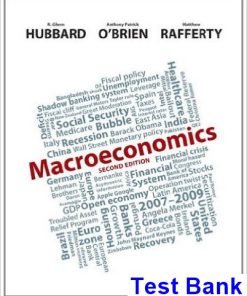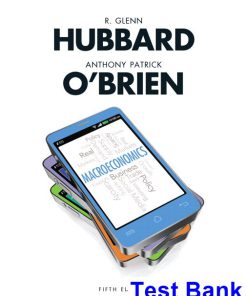$26.50$50.00 (-47%)
In stock
Macroeconomics Canadian 2nd Edition Hubbard Test Bank.
You may also like
Macroeconomics Canadian 2nd Edition Hubbard Test Bank

Product details:
- ISBN-10 : 013443126X
- ISBN-13 : 978-0134431260
- Author: Glenn Hubbard
By building from the specific example to the general case this text fosters student engagement. It delivers complete economics coverage using many fresh, lively, real-world examples from newspapers, magazines, Web sites, and professional journals from around the world.
Table contents:
- PART 1 The Power of Economics
- Chapter 1 Macroeconomics and Life
- Making an Impact with Small Loans
- The Basic Insights of Macroeconomics
- Scarcity
- Performance and Decision Making
- Incentives
- Efficiency
- An Economist’s Problem-Solving Toolbox
- Correlation and Causation
- Models
- Positive and Normative Analysis
- Conclusion
- Chapter 2 Specialization and Exchange
- The Origins of a T-Shirt
- Production Possibilities
- Drawing the Production Possibilities Frontier
- Choosing Among Production Possibilities
- Shifting the Production Possibilities Frontier
- Absolute and Comparative Advantage
- Absolute Advantage
- Comparative Advantage
- Why Trade?
- Specialization
- Gains from Trade
- Comparative Advantage Over Time
- Conclusion
- APPENDIX A Math Essentials: Understanding Graphs and Slope
- Creating a Graph
- Graphs of One Variable
- Graphs of Two Variables
- Slope
- Calculating Slope
- The Direction of a Slope
- The Steepness of a Slope
- PART 2 Supply and Demand
- Chapter 3 Markets
- Mobiles Go Global
- Markets
- What Is a Market?
- What Is a Competitive Market?
- Demand
- The Demand Curve
- Determinants of Demand
- Shifts in the Demand Curve
- Supply
- The Supply Curve
- Determinants of Supply
- Shifts in the Supply Curve
- Market Equilibrium
- Reaching Equilibrium
- Changes in Equilibrium
- Conclusion
- APPENDIX B Math Essentials: Working with Linear Equations
- Interpreting the Equation of a Line
- Turning a Graph into an Equation
- Turning an Equation into a Graph
- Equations with x and y Reversed
- Shifts and Pivots
- Solving for Equilibrium
- Chapter 4 Elasticity
- Canada’s Everyday Drink
- What Is Elasticity?
- Price Elasticity of Demand
- Calculating Price Elasticity of Demand
- Using the Mid-point Method
- Determinants of Price Elasticity of Demand
- Using Price Elasticity of Demand
- Price Elasticity of Supply
- Calculating Price Elasticity of Supply
- Determinants of Price Elasticity of Supply
- Other Elasticities
- Cross-Price Elasticity of Demand
- Income Elasticity of Demand
- Conclusion
- APPENDIX C Math Essentials: Calculating Percentage Change, Slope, and Elasticity
- Percentage Change
- Slope and Elasticity
- Q over P, or P over Q?
- Elasticity Changes Along Lines with Constant Slope
- Chapter 5 Efficiency
- A Broken Laser Pointer Starts an Internet Revolution
- Willingness to Pay and Sell
- Willingness to Pay and the Demand Curve
- Willingness to Sell and the Supply Curve
- Measuring Surplus
- Consumer Surplus
- Producer Surplus
- Total Surplus
- Using Surplus to Compare Alternatives
- Market Equilibrium and Efficiency
- Changing the Distribution of Total Surplus
- Deadweight Loss
- Missing Markets
- Conclusion
- APPENDIX D Math Essentials: The Area Under a Linear Curve
- The Area Under a Linear Curve
- Chapter 6 Government Intervention
- Feeding the World, One Price Control at a Time
- Why Intervene?
- Three Reasons to Intervene
- Four Real-World Interventions
- Price Controls
- Price Ceilings
- Price Floors
- Taxes and Subsidies
- Taxes
- Subsidies
- Evaluating Government Interventions
- How Big is the Effect of a Tax or Subsidy?
- Long-Run versus Short-Run Impact
- Conclusion
- PART 3 The Data of Macroeconomics
- Chapter 7 Measuring GDP
- It’s More than Counting Berries
- Valuing an Economy
- Unpacking the Definition of GDP
- Production Equals Expenditure Equals Income
- Approaches to Measuring GDP
- The Expenditure Approach
- The Income Approach
- The Value-Added Approach
- Using GDP to Compare Economies
- Real versus Nominal GDP
- The GDP Deflator
- Using GDP to Assess Economic Health
- Limitations of GDP Measures
- Data Challenges
- GDP versus Well-Being
- Conclusion
- Chapter 8 The Cost of Living
- Get Cracking
- The Cost of Living
- Measuring Price Changes Over Time
- The Market Basket
- Consumer Price Index
- The Challenges in Measuring Price Changes
- Using Price Indexes
- The Inflation Rate
- Deflating Nominal Variables
- Adjusting for Inflation: Indexing
- Accounting for Price Differences Across Places
- Purchasing Power Parity
- Purchasing Power Indexes
- PPP-Adjustment
- Conclusion
- PART 4 Labour Market and Economic Growth
- Chapter 9 Unemployment and the Labour Market
- What Does It Mean to Be Unemployed?
- Defining and Measuring Unemployment
- Where Does the Data Come From?
- Measuring Unemployment
- Beyond the Unemployment Rate
- Equilibrium in the Labour Market
- Categories of Unemployment
- Natural Rate of Unemployment
- Cyclical Unemployment
- Public Policies and Other Influences on Unemployment
- Factors That May Stop Wage Rates from Falling
- Employment Insurance
- Other Factors: Taxes and Worker Rights
- Conclusion
- Chapter 10 Economic Growth
- Why Economic Growth Matters
- Economic Growth Through the Ages
- History of World Growth
- Compounding and the Rule of 70
- Determinants of Productivity
- Productivity Drives Growth
- Components of Productivity
- Rates versus Levels
- Accounting for Growth
- Convergence
- Growth and Public Policy
- Investment and Savings
- Education and Health
- Technological Development
- Laying the Groundwork: Good Government, Property Rights, and Economic Openness
- The Juggling Act
- Conclusion
- PART 5 The Economy in the Short and Long Run
- Chapter 11 Aggregate Expenditure
- The Big Crash
- The Components of Aggregate Expenditure
- Consumption
- Investment
- Government Spending
- Net Exports
- Autonomous Expenditure and Simplifying Assumptions
- Aggregate Expenditure Equilibrium and the Keynesian Cross
- Actual versus Planned Aggregate Expenditure
- Keynesian Equilibrium
- Output Gaps
- The Multiplier Effect
- Conclusion
- APPENDIX E Math Essentials: Algebra and Aggregate Expenditure
- Using Algebra to Find Equilibrium Aggregate Expenditure
- Using Algebra to Derive the Expenditure Multiplier
- Chapter 12 Aggregate Demand and Aggregate Supply
- Pop! Goes the Bubble
- Tying It All Together
- Aggregate Demand
- The Aggregate Demand Curve
- Shifting the Aggregate Demand Curve
- The Multiplier and Shifts in Aggregate Demand
- Aggregate Supply
- The Difference Between Short-Run and Long-Run Aggregate Supply
- Shifts in the Short-Run Aggregate Supply Curve
- Shifts in the Long-Run Aggregate Supply Curve
- Do the LRAS and SRAS Always Shift Together?
- Economic Fluctuations
- Effects of a Shift in Aggregate Demand
- Effects of a Shift in Aggregate Supply
- Comparing Demand and Supply Shocks
- The Role of Public Policy
- Government Spending to Counter Negative Demand Shocks
- Government Spending to Counter Negative Supply Shocks
- Conclusion
- Chapter 13 Fiscal Policy
- From Prosperity to Great Recession
- Fiscal Policy
- Expansionary or Contractionary?
- Policy Response to Economic Fluctuations
- Real-World Challenges
- Policy Tools—Discretionary and Automatic
- Limits of Fiscal Policy: The Money Must Come from Somewhere
- The Government Budget
- Revenue and Spending
- The Budget Deficit
- The Public Debt
- Size of the Debt
- How Does the Government Go Into Debt?
- Is Government Debt Good or Bad?
- Conclusion
- PART 6 The Financial System and Institutions
- Chapter 14 The Basics of Finance
- Safe Investment?
- The Role of Financial Markets
- What Is a Financial Market?
- Information Asymmetries and Financial Markets
- Functions of Banks and Financial Markets
- The Market for Loanable Funds: A Simplified Financial Market
- Savings, Investment, and the Price of Loanable Funds
- Changes in the Supply and Demand for Loanable Funds
- A Price for Every Borrower: A More Realistic Look at Interest Rates
- The Modern Financial System
- Functions of the Financial System
- Major Financial Assets
- Major Players in the Financial System
- Valuing Assets
- The Trade-Off Between Risk and Return
- Predicting Returns: The Efficient-Market Hypothesis
- A National Accounts Approach to Finance
- The Savings–Investment Identity
- Private Savings, Public Savings, and Capital Flows
- Conclusion
- Chapter 15 Money and the Monetary System
- Cigarette Money
- What Is Money?
- Functions of Money
- What Makes for Good Money?
- Commodity-Backed Money versus Fiat Money
- Banks and the Money-Creation Process
- “Creating” Money
- Measuring Money
- Managing the Money Supply: The Bank of Canada
- The Role of the Central Bank
- How Does the Bank of Canada Work?
- Tools of Monetary Policy
- The Economic Effects of Monetary Policy
- Interest Rates and Monetary Policy: The Liquidity-Preference Model
- Interest Rates and the Economy
- Conclusion
- Chapter 16 Inflation
- A Land of Opportunity . . . and Inflation
- Changing Price Levels
- Measuring Inflation
- The Neutrality of Money
- The Classical Theory of Inflation
- The Quantity Theory of Money
- Other Causes of Changing Price Levels
- Why Do We Care about Changing Price Levels?
- Inflation
- Deflation
- Controlling Inflation . . . or Not: Disinflation and Hyperinflation
- Disinflation
- Hyperinflation
- Why a Little Inflation Is Good
- Inflation and Monetary Policy
- The Competing Goals of Maintaining Price Stability and Full Employment
- The Output Gap and Monetary Policy
- Inflation and Unemployment
- Conclusion
- Chapter 17 Financial Crises
- Walking Away from a Mortgage
- Origins of Financial Crises
- Irrational Expectations
- Leverage
- Two Famous Historical Financial Crises
- The 1970s and 1980s
- The Turn of the Century
- The Financial and Economic Crisis in Canada: Case Study
- Subprime Lending
- The Creation of the Housing Bubble
- Effects of the Housing Bubble Collapse
- A Domino Effect Toward Reduced Output
- The Immediate Response to the Crisis
- Stimulus at the Zero Lower Bound
- Recurrence of the Financial Crisis
- Conclusion
- PART 7 International Policy Issues
- Chapter 18 Open-Market Macroeconomics
- From Factory to Figures
- International Flows of Goods and Capital
- Imports and Exports
- Foreign Investment
- Balance of Payments
- International Capital Flows
- Determinants of International Capital Flows
- Effects of Foreign Investment
- Can a Country Save Too Much?
- Exchange Rates
- The Foreign-Exchange Market
- A Model of the Exchange-Rate Market
- Exchange-Rate Regimes
- Macroeconomic Policy and Exchange Rates
- The Real Exchange Rate
- Global Financial Crises
- The Role of the IMF
- Debt Crises
- Exchange-Rate Crises
- Conclusion
- Chapter 19 Development Economics
- Poverty Amid Plenty
- Development and Capabilities
- The Capabilities Approach
- Economic Growth and Economic Development
- The Basics of Development Economics
- Human Capital
- Institutions
- Investment
- Trade
- Migration
- What Can Aid Do?
- Perspectives on Foreign Aid
- Poverty Traps and the Millennium Development Goals
- The Major Distributors of Aid
- Problems with Foreign Aid
- Impact Investing
- How Do We Know What Works?
- Conclusion
- Glossary
- Endnotes
- Index
People also search:
Macroeconomics Canadian 2nd
Macroeconomics Canadian 2nd Edition Hubbard
Macroeconomics Canadian 2nd Edition Hubbard download scribd
Macroeconomics Canadian 2nd Edition Hubbard pdf free
Macroeconomics Canadian 2nd Edition Hubbard pdf












